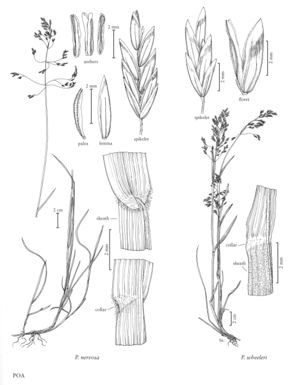Difference between revisions of "Poa nervosa"
FNA>Volume Importer |
FNA>Volume Importer |
||
| Line 17: | Line 17: | ||
-->{{Treatment/Body | -->{{Treatment/Body | ||
|distribution=Alta.;B.C.;Oreg.;Wash. | |distribution=Alta.;B.C.;Oreg.;Wash. | ||
| − | |discussion=<p | + | |discussion=<p>Poa nervosa occurs infrequently at low elevations in the western foothills of the northern Cascade Mountains and adjacent coast ranges, extending eastward up the Columbia Gorge as far as Multnomah Falls. It usually grows in wet habitats, such as mossy cliffs with seeps and around waterfalls, but it is also found in rich, old growth, mixed deciduous and conifer forests. It appears to be sexually reproducing and sequentially gynomonoecious.</p><!-- |
| − | --><p | + | --><p>Poa nervosa differs from P. wheeleri (see next) in having densely pubescent leaf collar margins, and glabrous or more sparsely and shortly pubescent sheaths. It also differs in usually having well-developed anthers, and in being tetraploid. The two species are geographically isolated and ecologically distinct. Plants from the Columbia River Gorge in Oregon, including P. xmultnomae Piper, that approach P. tenerrima (p. 588) are presumed to be derived from hybridization between P. nervosa (see previous) and P. secunda (p. 586).</p> |
|tables= | |tables= | ||
|references= | |references= | ||
| Line 34: | Line 34: | ||
|basionyms= | |basionyms= | ||
|family=Poaceae | |family=Poaceae | ||
| + | |illustrator=Sandy Long | ||
|distribution=Alta.;B.C.;Oreg.;Wash. | |distribution=Alta.;B.C.;Oreg.;Wash. | ||
|reference=None | |reference=None | ||
| Line 39: | Line 40: | ||
|publication year= | |publication year= | ||
|special status= | |special status= | ||
| − | |source xml=https:// | + | |source xml=https://bibilujan@bitbucket.org/aafc-mbb/fna-data-curation.git/src/314eb390f968962f596ae85f506b4b3db8683b1b/coarse_grained_fna_xml/V24/V24_764.xml |
|subfamily=Poaceae subfam. Pooideae | |subfamily=Poaceae subfam. Pooideae | ||
|tribe=Poaceae tribe Poeae | |tribe=Poaceae tribe Poeae | ||
Revision as of 16:09, 30 October 2019
Plants perennial; loosely tufted or with solitary shoots, short-rhizomatous. Basal branching mainly extravaginal. Culms 20-65 cm, erect or the bases decumbent, terete or weakly compressed; nodes terete, 1-2 exserted. Sheaths closed for 2/3 – 9/10 their length, terete to slightly compressed, smooth or sparsely scabrous, sometimes hairy, hairs about 0.15 mm, bases of basal sheaths glabrous, distal sheath lengths (0.7)1-2.2(2.8) times blade lengths; collars of proximal leaves usually hairy on and near the margins, marginal hairs longer than those of the sheaths; ligules 0.5-1.5 mm, smooth or scabrous, hairy, hairs about 0.15 mm, truncate to obtuse, those of the lower culm and innovation leaves 0.5-1 mm, scabrous or softly puberulent, truncate; innovation blades similar to or longer than the cauline blades; cauline blades 2-4.5 mm wide, usually flat, lax, adaxial surfaces smooth or sparsely scabrous, particularly over the veins, apices broadly prow-shaped, blades gradually reduced in length distally or the middle blades longest, flag leaf blades 3-8 cm long. Panicles 8-15 cm, erect or lax, ovoid to pyramidal, open or loosely contracted, sparse, with 25-80 spikelets, proximal internodes 1.8-3.5 cm; nodes with 3-5 branches; branches 2.5-8 cm, ascending to spreading, lax, terete to weakly angled, moderately scabrous, with 2-8 spikelets. Spikelets 4-7 mm, lengths to 3.5 times widths, laterally compressed, not sexually dimorphic; florets 3-8; rachilla internodes smooth or scabrous, glabrous or sparsely hispidulous. Glumes 2/3 – 4/5 as long as the adjacent lemmas, lanceolate, distinctly keeled; lower glumes 1-3(5)-veined; calluses usually glabrous, rarely minutely webbed; lemmas 3-4.5 mm, lanceolate, distinctly keeled, keels and marginal veins usually glabrous, infrequently sparsely softly puberulent to short-villous, intercostal regions glabrous or hispidulous, smooth or finely scabrous, margins glabrous, apices acute; paleas scabrous over the keels, intercostal regions glabrous; anthers usually 2.5-4 mm, sometimes vestigial (0.1-0.2 mm). 2n = 28, 28+1.
Distribution
Alta., B.C., Oreg., Wash.
Discussion
Poa nervosa occurs infrequently at low elevations in the western foothills of the northern Cascade Mountains and adjacent coast ranges, extending eastward up the Columbia Gorge as far as Multnomah Falls. It usually grows in wet habitats, such as mossy cliffs with seeps and around waterfalls, but it is also found in rich, old growth, mixed deciduous and conifer forests. It appears to be sexually reproducing and sequentially gynomonoecious.
Poa nervosa differs from P. wheeleri (see next) in having densely pubescent leaf collar margins, and glabrous or more sparsely and shortly pubescent sheaths. It also differs in usually having well-developed anthers, and in being tetraploid. The two species are geographically isolated and ecologically distinct. Plants from the Columbia River Gorge in Oregon, including P. xmultnomae Piper, that approach P. tenerrima (p. 588) are presumed to be derived from hybridization between P. nervosa (see previous) and P. secunda (p. 586).
Selected References
None.
